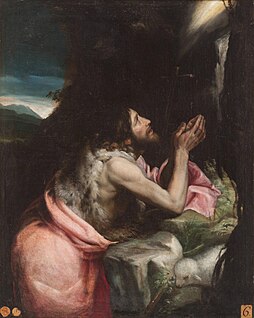 W
WPedro Berruguete was a Spanish painter whose art is regarded as a transitional style between gothic and Renaissance art. Berruguete most famously created paintings of the first few years of the Inquisition and of religious imagery for Castilian retablos. He is considered by some as the first Renaissance painter in Spain.
 W
WJuan de Borgoña, was a High Renaissance painter who was born in the Duchy of Burgundy, probably just before it ceased to exist as an independent state, and was active in Spain from about 1495 to 1536. His earliest documented work was painted in 1495 for the cloister of the Cathedral of Toledo. Borgoña’s compositions are well balanced with finely drawn figures in elegant, tranquil poses. They are set either against open spaces leading on to craggy landscapes or against gold embroidered drapery. There were a number of foreign painters active in Spain in this period, including Juan de Flandes. He brought the Quattrocento form of paintings into Castile.
 W
WJerónimo Vicente Vallejo Cósida was a Spanish Renaissance painter, sculptor, goldsmith and architect.
 W
WNicolás Factor was a Spanish Roman Catholic priest and a professed member from the Order of Friars Minor as well as a painter of the Renaissance period. Factor served as an apt preacher across his region - despite wanting to be sent to the foreign missions - and was noted for his practices of self-mortification before he gave sermons.
 W
WJuan de Flandes was a Flemish painter active in Spain from 1496 to 1519. His actual name is unknown, although an inscription Juan Astrat on the back of one work suggests a name such as "Jan van der Straat". Jan Sallaert, who became a master in Ghent in 1480, has also been suggested. He worked in the Early Netherlandish style.
 W
WDoménikos Theotokópoulos, most widely known as El Greco, was a Greek painter, sculptor and architect of the Spanish Renaissance. "El Greco" was a nickname, a reference to his Greek origin, and the artist normally signed his paintings with his full birth name in Greek letters, Δομήνικος Θεοτοκόπουλος, Doménikos Theotokópoulos, often adding the word Κρής Krēs, Cretan.
 W
WCristobal Lloréns was a Spanish painter, active during the late-Renaissance period. He lived in Valencia about 1597. He painted a history of St. Mary Magdalene and St. Sebastian for the conventual church of San Miguel de his Reyes.
 W
WFrancisco López was a Spanish painter and engraver. He was a pupil of Bartolommeo Carducci, whom he assisted in 1595 in painting for the church of San Felipe el Real at Madrid, destroyed by fire in 1718. He was appointed painter in ordinary to King Philip III of Spain. In 1603, he painted a series of paintings representing the victories of Charles V in the King’s dressing-room at the Pardo Palace. He also etched the third, sixth, and seventh plates for Vincenzo Carducci's Dialogues on Painting. He also painted Saint John the Baptist which is now at the Real Academia de Bellas Artes de San Fernando.
 W
WVicente Juan Masip was a Spanish painter of the Renaissance period. He is commonly considered the foremost member of the Valencian school of painters.
 W
WVicente Masip was a Spanish painter of the Renaissance period. His son was Juan Vicente Masip, and his grandson was named Vicente Masip Comes, also known as Vicent de Joanes.
 W
WAntonio Mohedano (1561–1625) was a Spanish painter of the Renaissance period.
 W
WFrancisco de Osona, also Francisco de Osona the Younger, (c.1465–c.1514) was a Spanish Renaissance painter.
 W
WRodrigo de Osona, also Rodrigo de Osona the Elder, (c.1440–c.1518) was a Spanish Renaissance painter.
 W
WJuan Pantoja de La Cruz was a Spanish painter, one of the best representatives of the Spanish school of court painters. He worked for Philip II and Philip III. The Museo del Prado contains examples of his severe portraiture style.
 W
WCristóbal Ramírez was a Spanish painter and illuminator of manuscripts for King Philip II of Spain. He was a native of Valencia, and did most of his work in his native city; he is known to have been active in 1566. He returned to el Escorial and died there, leaving his daughter and two sons under the king's protection. Among the books illuminated by this artist were the Oficio di difuntos, the Intonario, and the Brevario Nuevo en Cantoria for the Escorial.
 W
WJuan de Roelas, de las Roelas or Ruela was a Flemish painter whose entire documented career took place in Spain. He played a major role in the transition from Mannerist to Baroque painting in Spain.
 W
WPedro Romana (c.1460–1536) was a Spanish Renaissance painter.
 W
WLuis de Vargas (1502–1568) was a Spanish painter of the late-Renaissance period, active mainly in Seville. He traveled to Rome where he was influenced by Mannerist styles. He painted an altarpiece with multiple panels, including a Virgin and Child appearing to Adam and Eve or La Gamba for the Cathedral in Seville. He frescoed a Last Judgement for the Casa de Misericordia in Seville. Francisco Venegas was a student of his.
 W
WAlonso Vázquez was a Spanish sculptor and painter of the Renaissance period.
 W
WJuan Ximénez or Juan Jimenez was a Spanish painter.
 W
WMiguel Ximénez, was a Spanish Gothic painter.
 W
WFernando Yáñez de la Almedina, born in Almedina, Spain in c. 1475 and died in Valencia, Kingdom of Spain in 1536, was a Spanish painter. He was one of the most important early Renaissance painters in Spain. Of supposed morisco origin, he travelled to Italy to study fine art, and in the process became familiar with the work of Leonardo da Vinci. After returning to Spain, he collaborated with Hernando de los Llanos on many works.